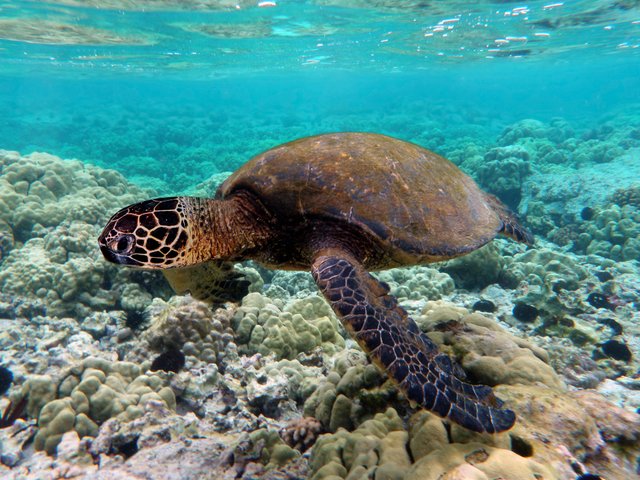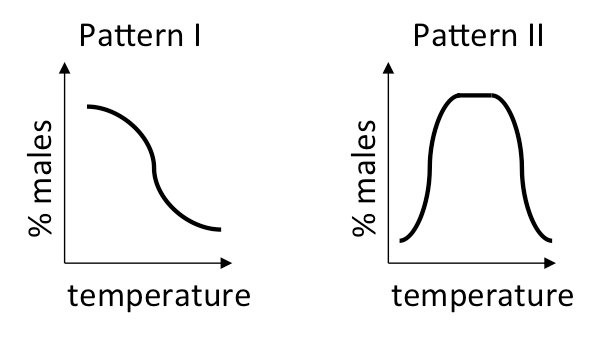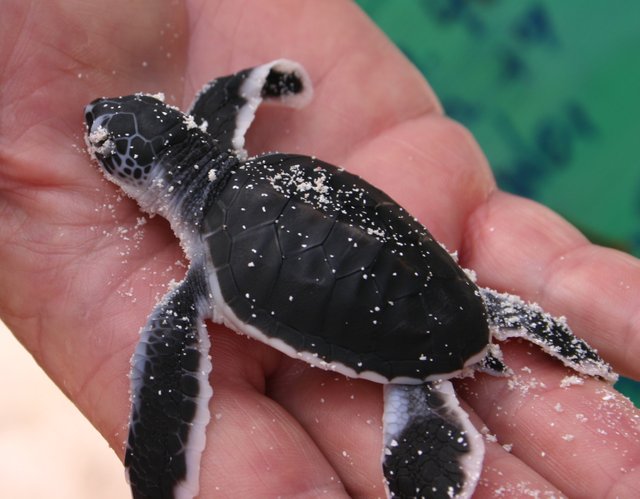Sea turtles use temperature-dependent sex determination instead of the commonly used sex chromosome, but climate change have shifted some populations to hatching as 99.8 % females!
Most animals have their sex determined by their chromosomes, but far from all! There are actually several different systems for determining the sex of the offspring, and in this post we are going to be looking closer at the system found in sea turtles, as well as discussing some problems with this in light of the global increase in average temperature.

A Green sea turtle. Image by Brocken Inaglory, posted with the Creative Commons Attribution-Share Alike 3.0 Unported license..
Sea turtles uses a system called temperature-dependent sex-determination (shortened TSD from here on out) in order to determine if the offspring will be male or female. This is very different from the commonly used chromosomal determination, because it allows for the environment to make the final call, not chromosomes. This means that it can be manipulated much more easily than other systems, and sea turtle (and other reptile) breeders can easily choose which sex they want to produce.
TSD is only found in reptiles, and fish from the infraclass Teleostei, so you won’t ever find this system in mammals or birds. The embryo will begin to develop its sexual system at around one-third of the complete embryonic development, so it is at this thermosensitive period that the temperature is determining the sex of the embryo inside the egg. However, the exact time of the thermosensitive period is different in the different species.
The two different patterns of temperature-dependent sex determination
There are two (or kind of three) different patterns for the TSD. The pattern IA has a single cutoff point where offspring produced below the threshold are males, and above it females. This is the system used by most turtles, including the sea turtles, so this is the one will we look a bit more closely at in the next section of the post.
The Pattern IB the exactly the same, but gives females below the transition zone, and males above it. This IB pattern only occurs in tarantulas.
The final Pattern II has two transition zones, and will produce females if the temperature is on the extreme side of either ends. This means that only a certain temperature will yield males, with the rest of them giving females. However, this system also tend to give a mix of both sexes from the same batch of eggs. This system is found in some lizards, crocodilians and turtles.

Here is a nice diagram to show you what I wrote. Diagram by Peteruetz, posted with the Creative Commons Attribution 3.0 Unported license.
You would not really need more than a 1-2 degree change in temperature to change the majority of the offspring’s sex, so they are really sensitive to changes in temperature. At this point you can probably see where I’m going with this
A recent paper suggests that over 99 % of all sea turtle offspring at the Great Barrier Reef is female because of a warmer climate
A group of researchers have been looking into how the increased global temperature has affected the organisms that use temperature-dependent sex-determination instead of chromosomal determined, specifically by looking at sea turtles’ genetics and matching these with their nesting beach. This allowed them to put both the males and the females they sample on a map to see if there was certain sites that produces more females then others.
The reefs are pretty much divided into northern and southern Great Barrier Reef nesting sites, where the northern one is a lot warmer because of climate change. The southern nesting site is not that badly affected (yet), and the results reflect this very clearly. In the northern (warm) nesting sites, 99.1 % of all juveniles, 99.8 % of all sub-adults and 86.8 % of all adults were female. On the colder southern nesting site, the results were much more normal, ranging between 65 % and 69 %.
This shows that the warmer nesting sites have a huge production of females, and the same paper suggests that this site has produced primarily females for over 20 years.
Many people believe that climate change might not be that bad because the temperature only rises a few degrees, but that is more than enough for the turtles. (And it will completely change a lot of other stuff in a very bad way as well, so don’t ever try to think that global warming won’t affect us humans). As of right now there are still some nesting sites that have not been as affected by the global warming yet, but that will most likely change as we keep burning hydrocarbons.

A hatchling. Image by Manuel Heinrich Emha, posted with the Creative Commons Attribution-Share Alike 2.5 Generic license.
This might not destroy the population all that quickly
At first glace we would expect this to completely destroy the population of sea turtles in this area since there are so few males, but this is not a certain scenario. Sea turtles do not need a 1:1 ratio like many monogamous species do, and a single male can fertilize the eggs of many females. Some scientists speculate that this might increase the population number, at least for the short-term. No one can tell much about the long-term effect of this extremely skewed sex ratio, since we don’t really have anything to compare it to, so we will just have to wait and see.
Thanks for reading
Thanks for reading about temperature-dependent sex determination as well as how this affect the sea turtles that nest close to Great Barrier Reef. I hope you learned something new, or at least found it to be an interesting read! Please leave me a comment below if you got anything you want to share, got a question, or just want to say hello.
The numbers are very scary. 99%!!! Global warming is a major issue in the Great Barrier Reef. In Australia, it is one of the best places to visit but sadly it's not in its best condition and hasn't been for the past few years. Please check out my recent post on coral bleaching in the GBR. Almost all the coral has been severely damaged due to changes in sea temperatures.
Yeah, it's terrible! The Great Barrier Reef is one of the places that have been hit the worst so far from global warming, and sadly many more places will start to see similar effects in the coming years.
It's so sad! Visiting the Great Barrier Reef has been a childhood dream of mine, but at this point I probably won't be able to do it before it's gone :(
Me too! I've always wanted to go snorkelling to see all the marine life close up, but never got the chance to. I hope in the future when I do get to go, it'll still be there.
I wish you the best of luck with realizing this dream, @betrayerx!
99% females. I bet the 1% is having a whale of a time ; )
Jokes aside this is seriously scary there will be serious knock on effects from this I am sure.
Haha, they surely are!
Yeah, I would think we get some huge side effects of this as well. I'm not too familiar with how the role of the sea turtles is in the ecosystem and the food webs, but I'm sure the upcoming population change will have some consequences.
I know they eat a lot of sea grasses so I would expect the grasses to start to choke their rivals if the turtle population drops
It's interesting to see how big consequences small environmental changes can have. I bet this is just scratching the surface, and there are many new discoveries to come.
Your article somehow reminded me about an article I read about wolves bring aspen trees back in Yellowstone. Just small changes that have big effects (both negative and positive).
https://www.yellowstonepark.com/things-to-do/wolves-bring-yellowstone-back
Yeah you're right about that. The temperature has generally "only" risen a few degrees in certain spots, but I cannot stress enough how big of a deal this actually is. A two degree average increase for an ecosystem is more than enough to change a lot of interactions there, potentially changing or destroying all of it. This small temperature is almost not sensed by us humans, but it's terrible for so many species.
The story of how the wolves changed so much in Yellowstone is such a cool read, and it is a very good example of how a little change can do so much. I am afraid that we will see a lot of these stories in the next 20 years once the consequences of the altered ecosystems begin to take real effect.
Thanks again for stopping by and leaving a valuable comment, @dieterschneider!
Great post, definitely learned something new. I read a scary post last year on how much of the Great Barrier Reef is actually destroyed today... global warming, of course, and then simply other human destructive behaviour.
I can see your love for nature through your posts... great profile, I'm now following you. I definitely share your sentiments. Keep up the good work and keep exploring! Jaco
Thank you for this comment, @extremejogging!
You are right about that; we are destroying the Great Barrier Reef much faster than most people think. Unfortunately most of the corals end up killing their symbiotic cells if the temperature rises only a few degrees, resulting in a coral bleach and the reef dying.
Ohhhh. An eye opener....90% vs 65%....
Seems like global warming has much more far reaching effects than we can fathom!
Yeah, there's such a huge gap between the sites. I could sadly not find out if 65 % is normal, or if the normal is 50 % though.
I'm afraid global warming will have huge and unforeseen consequences in addition to the ones we already fear..
Latest R&D work in all aspect of Science brought a revolution in our life. Temperature dependent sex determination itself is a big discovery of science. Global warming is already affecting green turtles and humankind. so the door of danger is ringing now it's our duty to at least do some things on our own behalf. nice sharing @valth
Yeah, it really is a big discovery, and it's so cool that organisms that are pretty closely related (such as reptiles and birds) can have so different sec determination systems.
I agree that it's our duty to do something about global warming, but sadly most of the world does not agree with us. I still think each and every one of us needs to improve ourself if we want to stop the increasing temperatures.
Wow. It is realy interesting information. I'm sorry for sea turtles. I think humanity destroys everything on earth..
Oh yeah, we are masters at destroying ecosystems and species, sadly..
It get worse day by day.
Other than this, there are interesting theories about the future. Do you heard anything about Antonio Garcia Martinez who is former manager of Facebook? He thinks 30 years later civilization will be come to an end because of technology..
Oh wow, I had not heard of that before. 30 years is very pessimistic! I hope he is wrong, but you never know now that things are going the way they are going..
Hello!
It is a wonderful information about sea turtles.
Thanks for the article.
Hello, @king-artur. Thank you for the kind words :)
Nice, things about sea turtles...
Well, nice is not really a word I would use to describe this, but sure ;)
@originalworks
The @OriginalWorks bot has determined this post by @valth to be original material and upvoted it!
To call @OriginalWorks, simply reply to any post with @originalworks or !originalworks in your message!